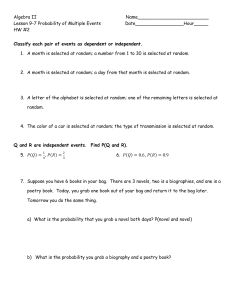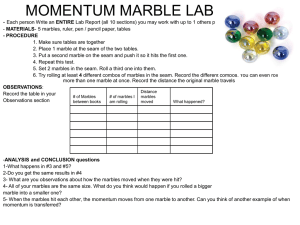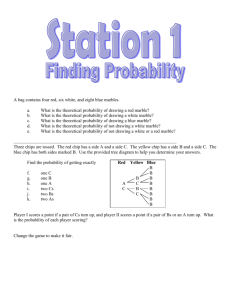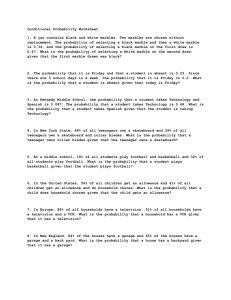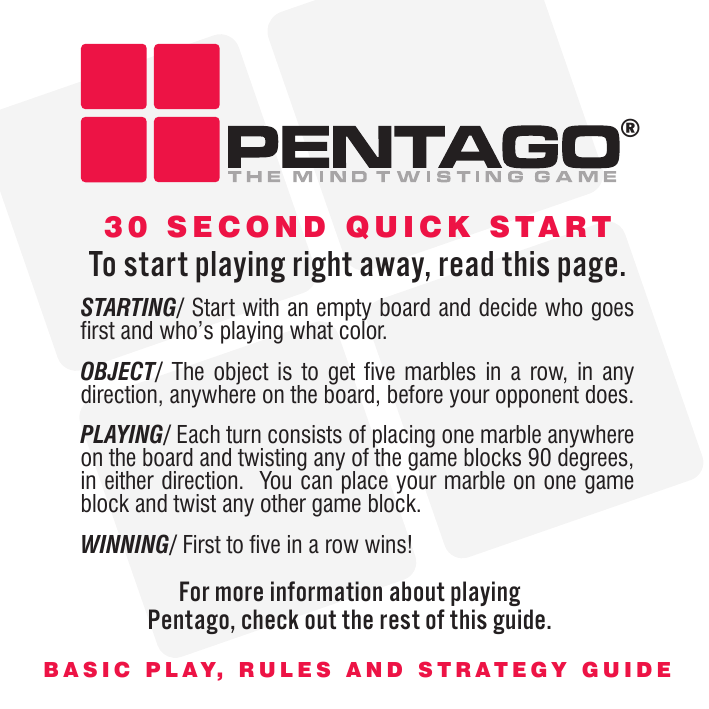
®
30 SECOND QUICK START
To start playing right away, read this page.
STARTING/ Start with an empty board and decide who goes
first and who’s playing what color.
OBJECT/ The object is to get five marbles in a row, in any
direction, anywhere on the board, before your opponent does.
PLAYING/ Each turn consists of placing one marble anywhere
on the board and twisting any of the game blocks 90 degrees,
in either direction. You can place your marble on one game
block and twist any other game block.
WINNING/ First to five in a row wins!
For more information about playing
Pentago, check out the rest of this guide.
B A S I C P L A Y, R U L E S A N D S T R A T E G Y G U I D E
B A S I C P L AY, R U L E S G U I D E
Welcome to Pentago, the mind twisting game from Sweden. In just
minutes, this guide will show you how to play, explain the few rules
that applies to Pentago play and give you some insight to basic
Pentago strategy.
STARTING/ The game starts with an empty game board, consisting of the base and
the four twistable game blocks. Decide marble color of each player. To determine
who goes first, disguise one of each color marble in your hands and have your
opponent choose one hand. The chosen color goes first and places a marble
anywhere on the game board.
OBJECT/ The object is to get five marbles in a row before your opponent does. The
mind twisting part of Pentago is that each player will also twist one of the four game
blocks 90 degrees (one “notch”), clockwise or counter clockwise, as part of each
turn. A 180 degree (double “notch”) twist is not allowed. The twist is the key to
create winning positions in Pentago.
PLAYING/ Players take turns at placing marbles on the game board and twisting
the game blocks. A player is free to twist any of the game blocks, regardless of
which game block the player placed the marble on. In the beginning of the game,
there will be neutral game blocks, allowing a player to ignore the twist portion of
their turn. A neutral game block is one that is empty or has only one marble in the
middle of it. Twisting a neutral game block will have no effect on the positional
nature of the game board so the twisting part of a move is optional while there are
neutral game blocks.
WINNING/ A winning row of five marbles can occur vertically, horizontally or
diagonally, anywhere on the board and will span two or three game blocks. What
seems like a simple five-in-a-row game quickly gets mind twisting as the board fills
up and both players are twisting the game blocks, creating a constantly changing
and challenging game scenario. You’ll want to really watch your opponents position
as it relates to yours and play as much defensive as you do offense.
SAMPLE GAME/ Here is an example of a game played between Red and Black
(the colors of your marbles may be different). In this game, Red went first.
The game starts with an
empty game board. This
guides refers to positions
on the game board as
indicated by the numbers.
Example; Position 2/5
refers to game block 2, the
middle position.
Red went first at 2/5,
followed by Black at 2/6.
Both players have made
three moves but neither
has twisted a game block,
since there hasn’t been a
need and one game block
still remains neutral.
Red places a marble at 1/4
with no twist and goes on
the offensive by getting
three in a row on game
block 1 and threatens to
get five-in-a-row on the
next turn. Now Black is in
trouble.
Black counters with
blocking
Red
by
placing a marble at
2/4 and twisting game
block 1 right.
Red continues the
offensive by placing
a marble at 3/5.
Red does not twist
because game block
3 is still neutral and
does not benefit from
twisting at this point.
B A S I C P L AY, R U L E S A N D S T R AT E G Y G U I D E
to twist a game block, even if doing so would have resulted in the opponent also
getting five-in-a-row.
TWISTING THE GAME BLOCKS/ A player can choose to ignore twisting
a game block in the first few moves of the game, while there are neutral game
blocks. A neutral game block is one that is empty or has only one marble in the
middle of it.
Black counters Red again
by blocking Red at 3/2 with
a marble and twists game
block 2 right.
Red now delivers the final
blow by placing a marble at
2/8 and twisting that game
block right for the win.
The final position of the
Red vs. Black game.
As this game shows, don’t let your opponent get three in a row on one game
block, or you’ll be on the defensive, sometimes with losing results. On the other
hand, sometimes playing defense for a few moves creates opportunities for you
that your opponent may miss because he/she can get too busy trying to run the
game.
At this point, play a few games to get a feel for Pentago play and the various
strategies and logic used to create good game technique. The constantly changing
game board will take a few games to get used to. Once you do, you’ll love to
explore all the perplexingly complex and deep logic that is required to conquer
another seasoned player.
TIES/ A tie can occur if both players have played all marbles and neither player
has five-in-a-row. A tie can also occur if one player twists his/her marbles into a
row of five, but also creates a row of five for the opponent. However, should one
player be able to win by simply placing a marble on the board for a row of five,
without twisting a game block, then that game is over, without that player having
Game block 3 is neutral because
twisting it would not change the
positional nature of the game
board, therefore twisting is
optional to both players at this
point of the game
Game blocks 1, 2 and 4 are
not neutral
Twisting a neutral game block will have no effect on the positional nature of the
game board so the twisting part of a move is optional while there are neutral game
blocks.
This does not mean that the player cannot twist a game block in the beginning of
the game, it is simply optional until such time that all game blocks have at least
one marble on it that isn’t in the middle, then you have to twist a game block as
part of your turn.
MATCH PLAY/ Playing a match is a common way to play Pentago. Match
play consists of playing best out of five games, meaning the first player to win
three games wins the match. Players alternate the start, since there is a slight
advantage to go first. Determine who goes first in the first match (see page 2).
The chosen color goes first in the first game of the match, then it alternates until
the match is finished.
The rules to Pentago are also printed inside the box, in case you lose this guide.
You can also download this guide in PDF format at Pentago.com.
B A S I C S T R AT E GY G U I D E
In Pentago, there are four ways to connect five marbles in a row
for a win. Each one is illustrated on pages 7 and 8, with a few
comments on its relative strength as a play, along with some
inherit advantages and disadvantages.
The game board can get infinitely complex and provide a challenge
to the most logically minded people. Because Pentago is so easy
to learn, beginners can play the game right away and enjoy the
simpler nuances of Pentago strategy and game play.
In three of the four ways to win, you need three marbles in a row
on one game block, in order to complete the winning five-in-arow. In most basic strategies, you’ll want to place marbles in
ways that creates three in a row on any one game block while
preventing your opponent from achieving the same. You’ll also
need some strategically placed marbles on other game blocks to
work with your set-up. Then on your turn, you strategically place a
marble on another game block and twist a game block to almost
magically form a winning row of five.
The play example on page 3 is a good example of first forming
three in a row on one game block, then creating a winning move
by placing a marble on another game block and twisting it into a
victory.
Lets take a look at the four ways that a winning row of five marbles
can occur on the Pentago board...
[1] MONICA’S FIVE [relative strength/3]
This is one of two diagonals plays and it goes right down the
diagonal middle. It’s a fairly obvious strategy and it’s easy
to defend against. It’s called Monica’s Five because one of
the designers girlfriend favored this technique. The designer
considered this a weak strategy and mostly ignored it and ended
up losing many a games to Monica. So while it is considered
the easiest strategy to defend against, it can obviously be rather
effective in certain situations.
Advantage/ your opponent can consider this position weak and
easy to defend against and ignore it.
Disadvantage/ it is easy to defend against by placing just one
marble in the middle of the cross corner opposite the game
block that your opponent is building this set-up on, that stops
your opponent from winning on this strategy.
Ways to increase its effectiveness/ place marbles on both
middle positions of the cross corner game blocks (as indicated
by the arrows), before developing three in a row on one game
block.
[2] THE MIDDLE FIVE [relative strength/5]
This play is a horizontal or vertical row of five in the middle of
two game blocks. Like Monica’s Five, it’s fairly easy to defend
against,
Advantage/ if you have three marbles and the middle of an adjacent
game block, it is a powerful position, especially if you have both
middles of both adjacent game blocks, then it’s almost always a
certain victory (see play example on page 3).
Disadvantage/ It’s fairly easy to defend against and it’s
somewhat obvious. You just need to block two positions on the
game board, the middle positions of the adjacent game blocks
from the one that your opponent is building a three on.
Ways to increase its effectiveness/ use in combination with
other plays, especially the Triple Power Play.
B A S I C P L AY, R U L E S A N D S T R AT E G Y G U I D E
[3] THE STRAIGHT FIVE [relative strength/7]
The Straight Five is one of the most powerful plays on the board
in that it takes a lot to defend against it, and even though the three
in a row on one game block is obvious, its versatility makes for
a powerful play.
Advantage/ versatility that results in a powerful position that
creates many deceptive ways of winning.
Disadvantage/ it’s not too hard to always make sure that you
prevent an opponent from ever achieving the three in a row
necessary to make this play. If your opponent does achieve three
in a row on one game block, it’s not too hard to make sure it’s
always twisted out of the way to prevent a win.
Ways to increase its effectiveness/ after building three in a row
on one game block, achieve several set-up positions for the win
by strategically placing marbles on the adjacent game blocks that
causes you to win no matter which way your opponent attempts
to twist the game blocks away from defeat.
[4] THE TRIPLE POWER PLAY [relative strength/9]
This is the most powerful play of the game in that it is deceptive
and versatile and it doesn’t require three in a row on any one game
block in order to set it up. It’s fairly hard to defend against, and it
has several different ways to set it up.
Advantage/ deceptive, versatile and hard to defend against. While
seasoned players will be able to spot the set-up early in the game,
it is very deceptive once the board fills up.
Disadvantage/ it’s a bit vulnerable to your opponent twisting your
set-up out of shape, even inadvertently.
Ways to increase its effectiveness/ make sure that you build
positions where indicated by the arrows on cross corner game
blocks, as the game develops.
S E T T I N G U P E A C H W I N N I N G P L AY
Below is a step-by-step guide of examples to set-up each of the
four winning plays. There are many ways to build towards each
formation, though we’ve just shown one example of each play
below, except in the Triple Power Play, which is so verstaile that it
cannot adequately be illustrated with just one example.
Remember that Pentago is both simple and complex at the same
time, which means that it is always good if you can use a measure
of deception in disguising your moves, or forcing your opponent
to play defense while you build a better positional advantage.
To keep things simple, only one players marble color is shown
in the examples, to illustrate how the set-up works. The idea is to
build towards these positions, starting with the opening moves
and throughout the game. Just remember to defend against your
opponent doing the same.
MONICA’S FIVE [the set-up]
1
2
3
4
Build this set-up.
On your turn, place
a marble at position
1/3, indicated by
the arrow.
On the same turn,
twist the game
block 1 according
to the arrow.
You just won by
using Monica’s Five!
B A S I C P L AY, R U L E S A N D S T R AT E G Y G U I D E
THE MIDDLE FIVE [the set-up]
1
3
4
1
2
3
4
The Triple Power Play is very versatile and there are several ways to set it up.
Shown below is two more examples of the Triple Power Play set-up.
Every example is set-up just like the first one, in terms of;
1) Build towards this set-up as you play the game.
2) On your turn, place the marble..
3) ..Make the twist..
4) ..The win!
THE STRAIGHT FIVE [the set-up]
1
10
2
THE TRIPLE POWER PLAY [the set-up]
2
3
1
2
3
4
1
2
3
4
4
11
®
Now that you have the basic idea of playing Pentago,
you’ll have fun for hours with this simple yet complex
and mind twisting game. For more information on
Pentago, see Pentago.com
THE GAME AND NAME PENTAGO IS A TRADEMARK OF TOMAS FLODÉN. ALL OTHER TRADE NAMES AND TRADE DRESS USED
IN THIS GUIDE ARE TRADEMARKS OR REGISTERED TRADEMARKS OF MINDTWISTER USA OR MINDTWISTER AB.
© 2005 MINDTWISTER USA, INC. ALL RIGHTS RESERVED. PATENT PENDING. TMFX




